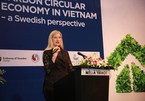According to Nguyen Bich Lam, general director of the General Statistics Office (GSO), Vietnam’s GDP growth rate in 2018 was over 7 percent, the highest level since 2008. The GDP in the first nine months of 2019 grew by 6.9 percent compared with the same period in 2018, the highest level compared with the same period of the last 9 years.

Of the factors that made up GDP growth in the first nine months of the year, agriculture, forestry and fishery accounted for the smallest proportion due to drought and climate change which affected yield and output.
The growth rate of the processing and manufacturing industries, 11.3 percent, was the major driving force of the economy.
Though the economy gained a high growth rate in the first nine months, the Central Institute of Economic Management (CIEM) has warned of uncertainties.
| Of the factors that made up GDP growth in the first nine months of the year, agriculture, forestry and fishery accounted for the smallest proportion due to drought and climate change which affected yield and output. |
“The manufacturing and processing industries contributed the most to the growth if calculating the percentage points, but I can see that tmmining has come back after 3 years of negative growth and rapid increase in inventories. That is, enterprises create high product output, but cannot create purchasing power in the market,” said Nguyen Anh Duong from CIEM.
“The growth rate is high, but there is no quality improvement,” he said.
Nguyen Dinh Cung, former head of CIEM, also warned that all three driving forces behind the growth, namely export, state’s investment and foreign investment, show problems.
Cung said the US, with the export growth rate of 26.6 percent, was saved Vietnam’s exports. Meanwhile, exports to the EU decreased by 1.9 percent and the Chinese market by 2.9 percent. This has put Vietnam at high risk.
According to GSO, Vietnam’s economy is facing challenges, including the slow disbursement of public investment capital, which is described as a ‘bottleneck’ in the national economy.
In the first nine months of 2019, the total disbursed capital was VND247 trillion, just 60 percent of the plan.
Meanwhile, each one percent increase in public investment capital will lead to 0.6 percent increase in GDP, according to Nguyen Viet Phong from GDP.
Economists say GDP is not the only tool needed to reflect the health of the economy.
Vo Tri Thanh, a respected economist, said the shortcoming of GDP is that it only counts the production capacity within the border, and does not separate the income that foreign investors receive in Vietnam and transfer abroad.
Thanh Lich

Expert warns of impact of Vietnam’s slowing industrial activities on GDP growth
Vietnam's headline PMI from Markit’s survey and month-on-month IPI indicated slowing industrial activities in September, potentially causing negative impacts on GDP growth in the remaining months of the year.

Vietnam urged to promote circular economy
Vietnam should act fast to switch to the circular economy, heard a workshop on promoting the no-carbon circular economy held in Hanoi on November 12.
 Vietnam is among the countries with the highest GDP growth rates in the region.
Vietnam is among the countries with the highest GDP growth rates in the region.